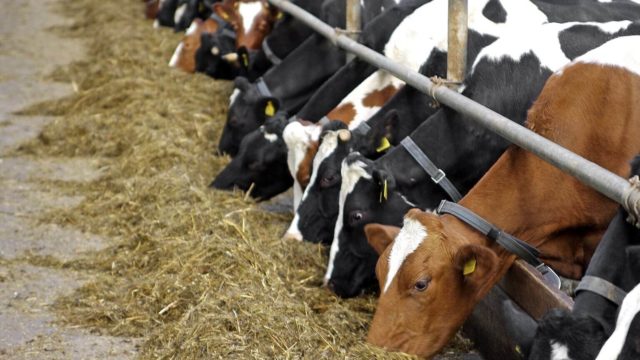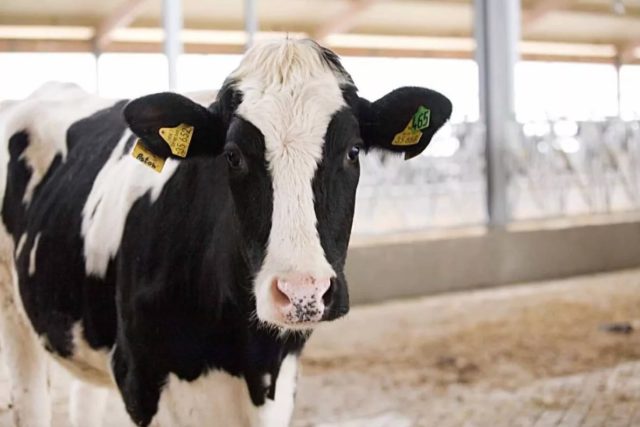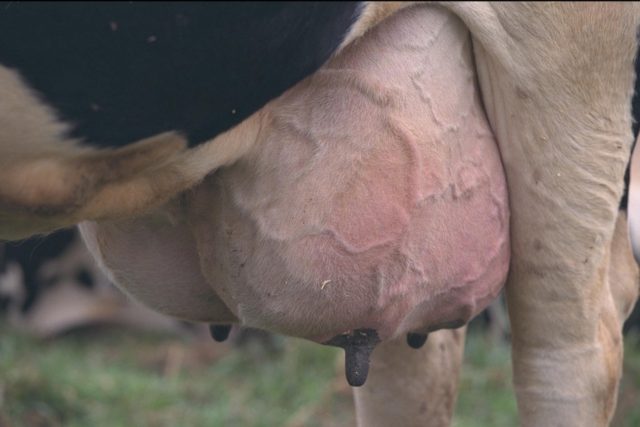Content
Dermatitis of the udder in cows is an inflammatory process that forms in the deep layers of the skin. It can be both acute and chronic. This article will provide detailed information about the types of udder dermatitis, the causes, its symptoms, and the rules for helping the animal.
Types of udder dermatitis
Cows can have one of the following types of dermatitis:
- traumatic, which is caused by mechanical damage to the skin;
- medication against the background of the use of medications or ointments;
- verrucous (warty), which becomes a consequence of advanced medical or traumatic dermatitis, has a chronic form;
- gangrenous - when a necrobacteriosis pathogen enters through skin lesions - necrosis sticks;
- nodular - due to viruses of the nitling group.
Causes of udder dermatitis in cows
Udder dermatitis can be caused by:
- prolonged hypothermia of the animal;
- chapping a wet udder;
- the use of acute ointments for the treatment of various diseases in the udder area;
- non-observance of sanitary and hygienic standards and rules for caring for animals.
In some cases, dermatitis can be a consequence of disturbed metabolic processes in a cow, or it occurs against the background of damage to other areas and organs by the disease. This is typical for food intoxication, which is divided into potato, buckwheat, bard and clover exanthema.
Symptoms of the disease
The disease can be easily identified by external clinical signs. They can be of varying severity - from small foci of pale red inflammation to serious purulent lesions of the udder. The most severe degree is usually located in the middle of the left and right udder thickening, but can spread throughout the entire area.
Painful ulcers form from cracks, from which the ichor is constantly released with an admixture of pus. With insufficient care or untimely detection, these cracks become covered with a thin crust or, mixing with dirt and dust, form a mass with a characteristic unpleasant odor, which sticks together the wool and gives the animal even more discomfort. In addition to the formation of cracks and ulcers on the skin, purulent foci of various sizes begin to appear throughout the udder - from barely noticeable to large - the size of a walnut. If the skin lesion affects the nipples and the nipple area, daily milking causes severe pain and anxiety in the animal.
Diagnostics
In most cases, a general clinical examination is sufficient to diagnose dermatitis, which helps to make an accurate diagnosis. This is due to the fact that the symptoms of the disease appear almost immediately. To determine lumpy dermatitis, it is necessary to conduct laboratory tests of saliva, as well as discharge from mucous membranes. Be sure to separately examine the affected areas of the udder.The incubation period for lumpy skin disease can last a month, however, the first signs begin to appear as early as the second week after infection.
How to treat udder dermatitis in cows
The outcome of udder dermatitis in cows with the right treatment is positive. Non-infectious forms of the disease respond most easily to therapy. For them, it is necessary to eliminate the cause of the disease (adjust the temperature regime, observe care, maintain cleanliness in the room). Then the dermatitis will recede by itself.
But if the disease is of an infectious origin, complex treatment may be needed using various drugs, rubbing and solutions. Treatment takes place in several stages:
- Elimination of the cause of occurrence... With dermatitis, the animal suffers from severe constant itching, so it constantly itches. Constant exposure to irritated skin causes inflammation and trauma in the form of cracks and wounds. Therefore, the first step is to remove the cause that causes irritation of the skin. For example, if dermatitis manifests itself while taking certain medications, it is worth limiting their use and looking at the results. To identify the cause, you should know the types of dermatitis and what causes them. Information on this can be found in one of the previous sections.
- Trimming the affected areas... In areas with ulcers, cracks and irritations, all hair should be removed. This will facilitate post-treatment, allow the skin to breathe freely and prevent dirt and sweat from accumulating in the affected areas. And in the summer, under the influence of ultraviolet rays, the skin will regenerate and dry faster.
- Cleaning wounds with soap and water... On the affected areas, ichor and cracks quickly form. To prevent dirt and infection from getting into them, they must be constantly washed with plain clean water and antibacterial soap. After sanitizing the skin, wipe it off with a dry napkin. Never leave your skin wet.
- Selection of complex drug treatment... It is advisable that medications and other therapeutic measures are prescribed by a qualified veterinarian. However, it is not always possible to resort to his services, therefore, first you need to correctly determine the type of dermatitis, organize treatment depending on its origin and clinical manifestations.
If the dermatitis was caused by taking antibiotics or mechanical damage to the skin, it is recommended to treat the udder with alcohol solutions with the addition of antiseptics. Pioctanine is very popular for these purposes. Also, to prevent the further spread of the disease, it is recommended to use ointments and gels for disinfection, for example, balsamic liniment, zinc or streptocide ointment.
In some cases, a course of antibiotics is prescribed for therapy, as well as a blockade of novocaine. For the treatment of warty dermatitis, various cauterizing solutions of turpentine, formalin or potassium permanganate are used. In the advanced stages of the disease, one cannot do without surgical operations with the imposition of a dense plaster cast.
As therapeutic measures against lumpy dermatitis, antibiotics are used - Tetracycline and Oleandomycin. To maintain the condition of the animal, a course of vitamins is prescribed, and also monitors its proper nutrition and sufficient rest.
Prophylaxis
Preventive measures can help prevent the appearance of dermatitis. These include:
- Compliance with sanitary and hygienic standards when keeping an animal... The room must be warm and dry. Be sure to have a thick and clean pad on the floor so that the animal does not sleep on a hard and dry floor. Regularly it is necessary to monitor the hygiene of the cows - once every 1-2 days, wash and wash the udders dry.When processing the skin, its constant diagnosis should be carried out for the appearance of mechanical damage and irritation for their timely elimination. If cracking is associated with specific medications, treatment should be stopped immediately and the cow should be monitored until symptoms disappear completely.
- Vaccination... Such a preventive measure is needed solely to prevent the appearance of infectious dermatitis. If the animal has already suffered this disease once, it develops a stable immunity to it. Therefore, such a preventive measure is considered the most effective way.
- Quarantine... If a new animal arrives in the barn, it must be kept separately for the first month using individual care items. You should also refrain from importing animals from unfavorable areas, for example, from India, where almost all cows are infected with one or another infectious disease. It is recommended that all tests be done immediately after admission. And only after the results are obtained, the cow can be transferred to the common room.
Conclusion
Dermatitis of the udder in cows with timely diagnosis is easily treatable. To prevent it, it is necessary to observe preventive measures, vaccinate animals and take a responsible attitude to the import of new cows into the common barn.













